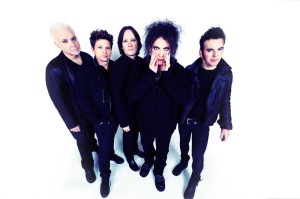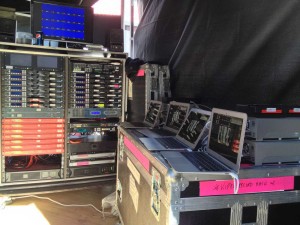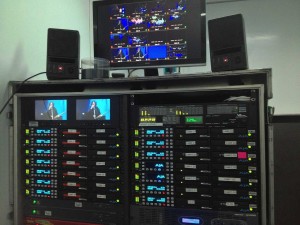
When assembling his setup for the tour, Harvey wanted to go with a system that would stand up to the pressures of operating in less technically advanced locales, such as Brazil, Argentina, Chile, Paraguay, Columbia and Mexico City. Anticipating more than 300 hours of footage that needed to be turned around quickly, tape was not an option. The editors also encouraged him to deploy a pipeline that would support the Avid DNxHD 220 codec for editorial, so he turned to AJA‘s Ki Pro Rack to record the footage.
“We were going to be dealing with a tremendous amount of footage so we needed a recorder that could capably handle the data as well as withstand the physical demands of the road,” explained Harvey. “It was also crucial to have the DNxHD codec for dailies ingest.”
Though Harvey was quite familiar with Ki Pro technology, the tour marked the first time that he used Ki Pro Rack units for multi-camera recording. He relied on up to 14 Ki Pro Racks and one Ki Pro to record each performance, which were captured with anywhere from seven to 15 cameras. A typical show would have 10 cameras feeding into ten Ki Pro Racks with a line cut out of a switcher and a backup, for a total of 12 outputs. Due to varied availability depending on the region, Harvey often had to mix and match different HD cameras, as the gear and crews were all locally hired.
 “In Chile, we ended up renting a broadcasting truck that was actually the back end of an old transit van welded to the front of a U-Haul tow unit with a flat screen inside,” Harvey said. “It was nice to have such solid recorders, considering the cameras ranged from top-line HD to prehistoric Stone Age HD, but that is the kind of challenge you have to put up with when keeping up with the pace of a concert tour on the road across South America when taking your own video truck is not an option.”
“In Chile, we ended up renting a broadcasting truck that was actually the back end of an old transit van welded to the front of a U-Haul tow unit with a flat screen inside,” Harvey said. “It was nice to have such solid recorders, considering the cameras ranged from top-line HD to prehistoric Stone Age HD, but that is the kind of challenge you have to put up with when keeping up with the pace of a concert tour on the road across South America when taking your own video truck is not an option.”
During the show, Harvey monitored each feed and camera to ensure the Ki Pro Racks and Ki Pro were operating properly. When shooting was complete, the data from the recorders’ KiStor drives was transferred via the new AJA KiStor Docks with their Thunderbolt and USB 3.0 connections to five G-Tech 8 TB drives connected to five Mac laptops. Each show averaged 350 GB of data per camera – more than seven and half TB of data after eight shows. After the masters were created, data was transferred to backup then the recorders were wiped and prepped for the next show.
“Working digitally saved us a ton of time, especially considering the massive amount of footage we were capturing,” explained Harvey. “Also, we were able to offer an H264 live encode of the whole show – in HD 1920 x 1080 30P compressed to MPEG-4 – on a USB drive right after the show, so that Robert Smith and the director could review for feedback and input, informing future shows.”
 Additionally, Harvey was able to record his multiscreen setup view of his system with all running cameras in a 4 x 4 picture in picture box. The images came in directly from the Ki Pro Racks (BITC output), so the director, Tim Pope, could watch the multi-view as if he were viewing a monitor gallery display in a truck and take notes. Recorded at 720P, Pope could review files that were a nice quality but not overly large, making edit selects easier when doing the offline/online postproduction back in London.
Additionally, Harvey was able to record his multiscreen setup view of his system with all running cameras in a 4 x 4 picture in picture box. The images came in directly from the Ki Pro Racks (BITC output), so the director, Tim Pope, could watch the multi-view as if he were viewing a monitor gallery display in a truck and take notes. Recorded at 720P, Pope could review files that were a nice quality but not overly large, making edit selects easier when doing the offline/online postproduction back in London.
Short & Spikey specializes in the video engineering production of live stage shows for high profile musical acts. Over the last 12 years, the company has worked with Lady Gaga, Cher, Madonna, Bon Jovi, Paul McCartney, Christina Aguilera and Van Halen.





